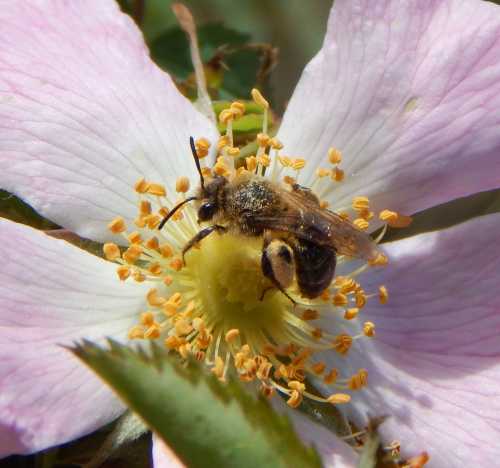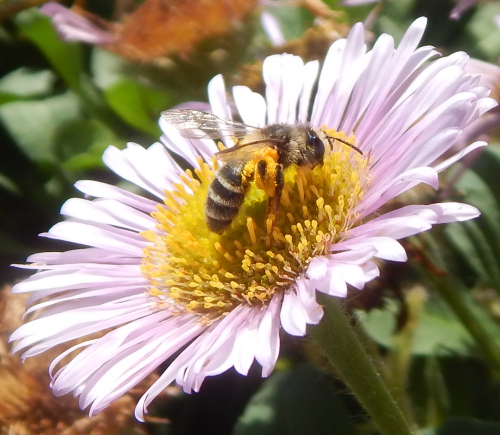The Ashy Mining Bee
- Andrena cineraria
Updated: 9th March 2023
The Ashy Mining Bee - Andrena cineraria, is a harmless and beautiful ground nesting bee, and its distinct black and whitish hair makes it easy to identify.
A member of the Andrenidae bee family, this species may be found in a variety of locations, including gardens, open woodlands, valleys, greenspaces, brownfield sites and coastal grasslands.
Identifying Ashy Mining Bees - Andrena cineraria
Pictured below is a female, having two well-defined pale bands on the thorax and a pale tuft of hair on the front of the head
The abdomens of females are actually blackish-blue and quite shiny. Females have notably thicker rear legs than males - watch the video for more images.
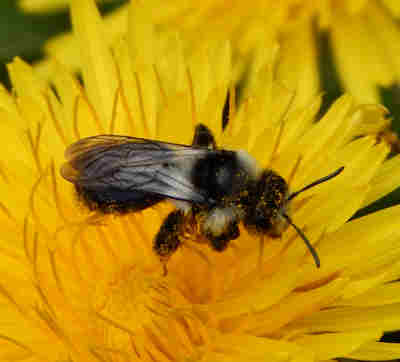 Above: Ashy Mining Bee - Andrena cineraria (female) on dandelion
Above: Ashy Mining Bee - Andrena cineraria (female) on dandelionThe image below offers a clearer view of the abdomen of an Ashy Mining Bee female.
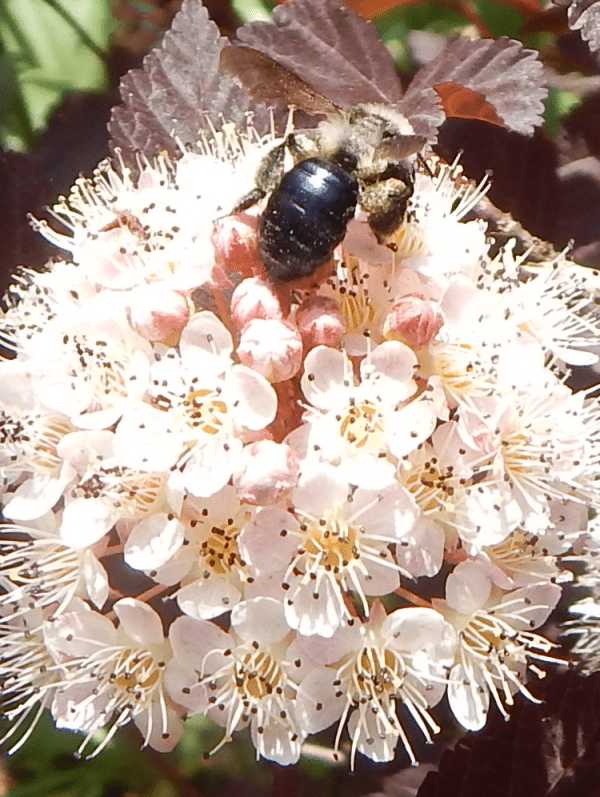 Ashy Mining Bee - Andrena cineraria (female) foraging on a shrub in my garden - Physocarpus opulifolius 'Diabolo'
Ashy Mining Bee - Andrena cineraria (female) foraging on a shrub in my garden - Physocarpus opulifolius 'Diabolo'Below is a male.
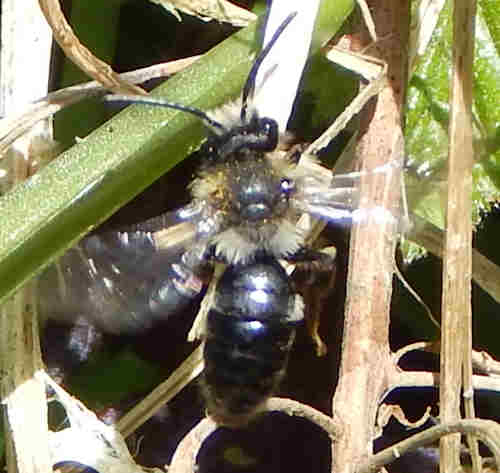 Above: Ashy Mining Bee - Andrena cineraria (male)
Above: Ashy Mining Bee - Andrena cineraria (male)Males are slimmer than females, and have a few greyish white hairs on the sides and toward the tip of the abdomen, and slimmer hind legs.
The facial hairs form a conspicuous 'tuft'.
Ashy Mining Bee Habitat
Ashy Mining bees may be seen in a wide variety of habitats, from gardens to brownfield sites, coastal grassland or open woodland.
They seem to like south-facing slopes.
Indeed the female in the image at the top of the page was photographed on an allotment. The allotment was in a cutting on sloping land, with sloping boundaries.
In the immediate area were wild hedgerows, wildflowers (including dandelions, of course), and fruit trees (it being an allotment).
There were also fruit trees, large numbers of buttercups and umbellifers (notably giant hogweed!).
The male, on the other hand, was photographed in a grassy area on a hill, surround by woodland and English Bluebells with Hawthorn nearby - see below.
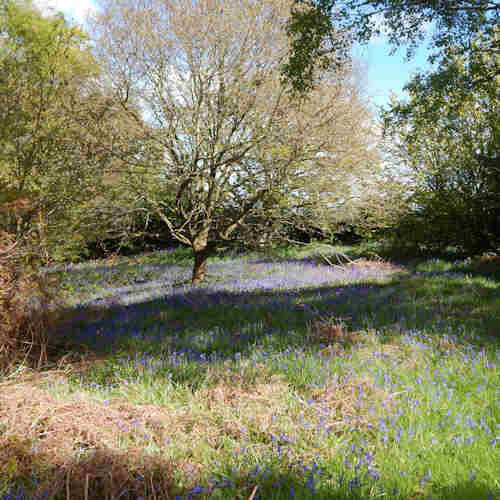 The habitat featured open wooded areas with English Bluebells, a few dandelions and also nearby, Hawthorn.
The habitat featured open wooded areas with English Bluebells, a few dandelions and also nearby, Hawthorn.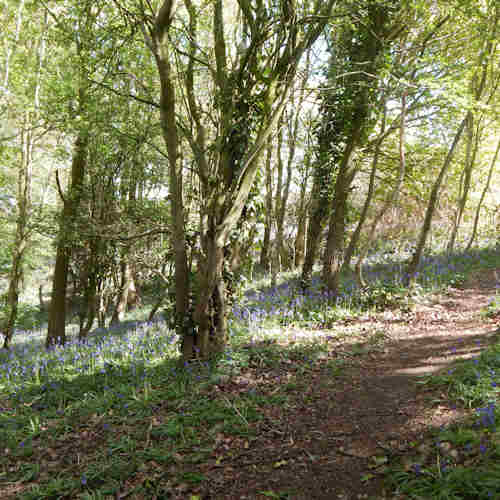 The woodland slope gently, and provides light shade.
The woodland slope gently, and provides light shade.I submitted my photographs to a scheme recording sightings of Andrena cineraria. One of the questions asked was whether the ground was sloping and whether shade was available.
On both occasions when I have observed this species, sloping ground and available shade was a feature of the immediate landscape, although I do not know if these features are always selected by this particular bee.
Nests
These mining bees often nest in aggregations – or communal groups. Larvae develop and mature in the cells, and eventually overwinter underground as adults in the natal cells.
According to BWARS1, females excavate burrows in the ground of about 10 – 20cm in depth, with two or three cells per burrow. This species has the interesting habit of closing the entrances to their burrows when disturbed or during wet weather, but keep them open otherwise, including between foraging trips.
However, the depth of the burrows excavated by females may vary.
In one study2 undertaken in the Kashmir Valley, aggregations of Andrena cineraria were found at altitudes ranging from 1613 to 2730 meters above sea level.
The nests were studied during the years 2013, through to 2016 and occurred in barren, hilly lands near fruit orchards and other landscapes, and in clay loam soil types. The nests were 29–36 cm in depth, with a maximum density of 11.09 nests per m2.
When Is The Ashy Mining Bee Seen?
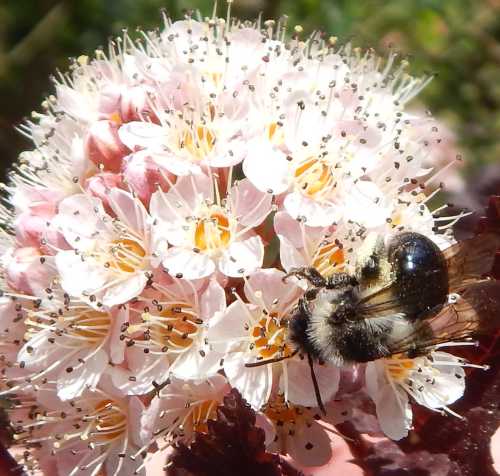
They are usually univoltine (meaning they have one brood period). Females are active mating, then nesting from April to June, with males flying out from March to April, and mating with females around April.
It is not clear whether later recordings suggest a second brood period, or delayed emergence of bees.
Foraging: Plants and Flowers for Ashy Mining Bees
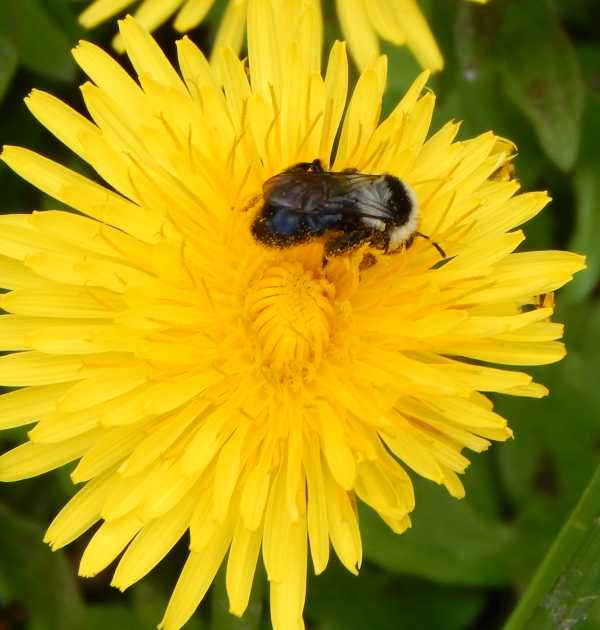
Andrena cineraria, are polylectic, meaning they will forage from a range of unrelated and diverse plant species.
They may be seen along verges and hedgerows foraging on buttercups (Ranunculus spp.), dandelion (Taraxacum officinale), daisies (Bellis perennis) mustards (Brassica spp.), Gorse (Ulex Europaea), Blackthorn (Prunus spinosa), Hogweed (Heracleum sphondylium), and brambles (Rubus spp.).
You can encourage them to visit your garden with fruit trees (especially cherry, plum and pears), willows (Salix spp.), and wild roses (Rosa spp.).
Natural parasites
The nomad bee Nomada goodeniana and Nomada lathburiana are cleptoparasites known to target the ashy mining bee.
Fly parasites include the bee fly Bombylius discolor.
The conopid fly is a further potential parasite.
Read about the Chocolate Mining Bee
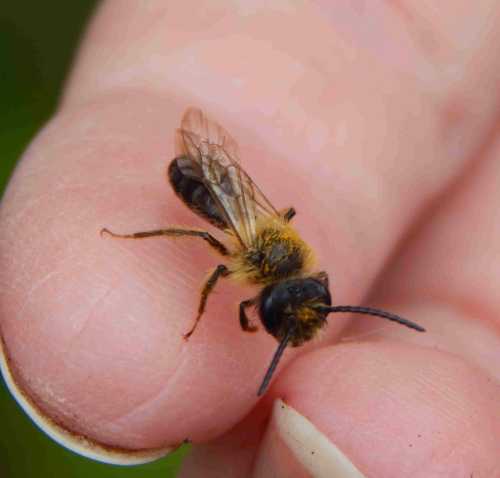
References
1. Nigel Jones (2011) - BWARS - Bees Wasps And Ants Recording Society.
2. Showket Ahmad Dar, Muneer Ahmad Sofi, M. El-Sharnouby et al., Nesting behaviour and foraging characteristics of Andrena cineraria (Hymenoptera: Andrenidae) Andrena cineraria –>, Saudi Journal of Biological Sciences, https://doi.org/10.1016/j.sjbs.2021.04.063.
If you found this page helpful or interesting, I'd really be grateful if you would share it with others - if not this page, perhaps another, such as Gardening For Bees.
Thank you so much :) .
